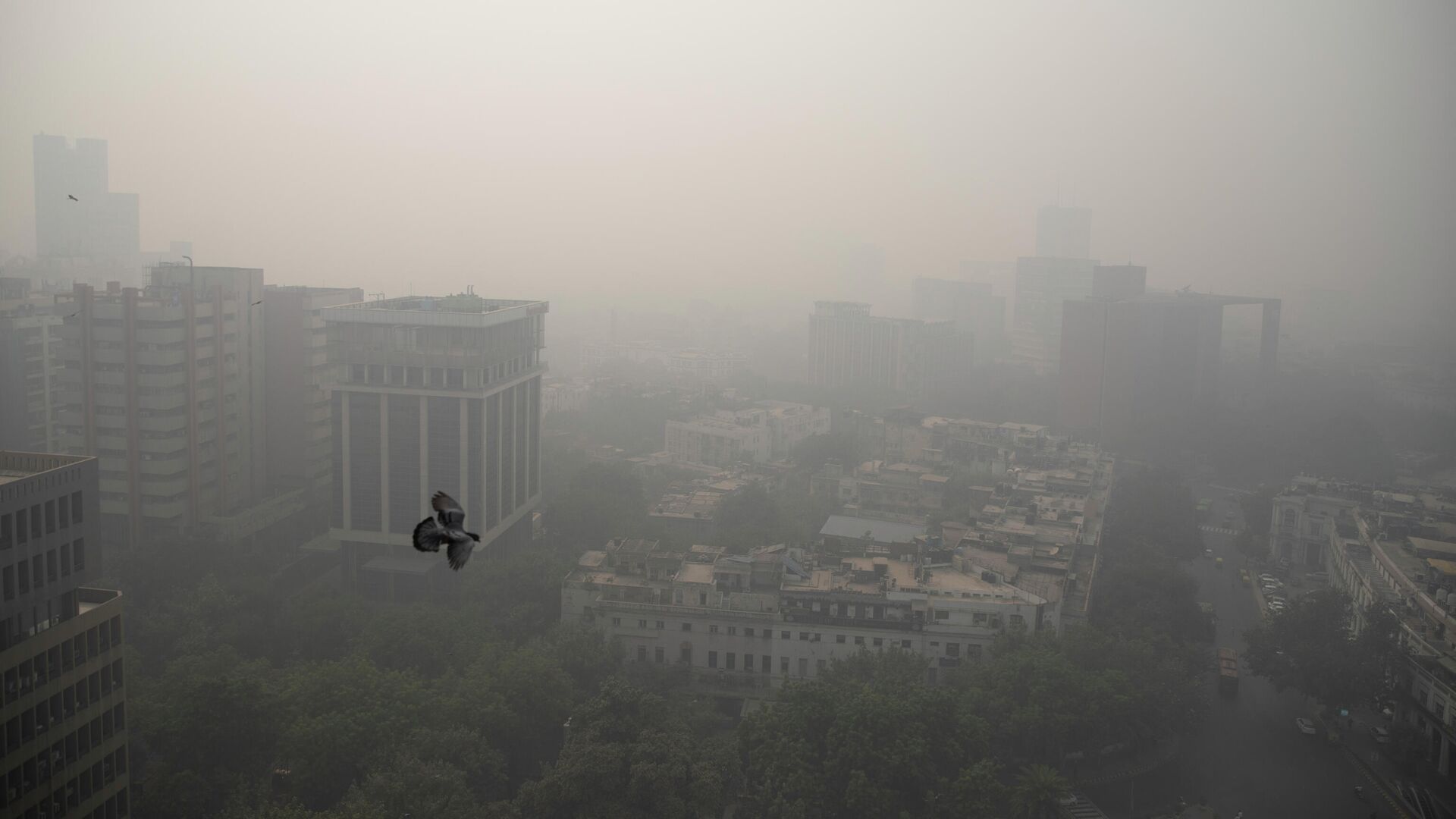https://sputniknews.in/20230129/plastic-tsunami-how-pakistans-pollution-crisis-has-left-population-overwhelmed-in-rivers-of-waste-684930.html
Plastic Tsunami: How Pakistan's Pollution Crisis Has Left Population Overwhelmed in Rivers of Waste
Plastic Tsunami: How Pakistan's Pollution Crisis Has Left Population Overwhelmed in Rivers of Waste
Sputnik India
In conversation with Sputnik, Urban Planner and CEO of Vesta Architects Arsalan Khalid explained why Pakistan is going through a plastic crisis.
2023-01-29T23:50+0530
2023-01-29T23:50+0530
2023-01-29T23:50+0530
world news
pakistan
health crisis
humanitarian crisis
https://cdn1.img.sputniknews.in/img/07e7/01/0b/454121_0:320:3073:2048_1920x0_80_0_0_2a704dfff7fb70b0958cba3796e0a62c.jpg
In a conversation with Sputnik, urban planner and CEO of Vesta Architects Arsalan Khalid explained why Pakistan is going through a plastic crisis.He further elaborated that apart from the single-use plastic bag problem, there's also a problem of widely-used PET (polyethylene terephthalate) bottles.Landfills of Toxic ChemicalsAccording to the Pakistan Plastic Manufacturers Association, the nation uses some 55 billion plastic bags each year.One of the most visible effects of plastic pollution in Pakistan is the damage it causes to wildlife. Plastic waste can entangle and suffocate animals, and it is also mistaken for food by many species, leading to starvation and death. Marine animals are particularly vulnerable, with plastic waste often flowing into the oceans and washing up on beaches.This not only harms the animals themselves, but it can also impact entire ecosystems, as plastic can disrupt the food chain and lead to a decline in biodiversity.In addition to harming wildlife, plastic pollution also has a negative effect on human health. The waste contains toxic chemicals, which can leach into the environment and contaminate soil and water. This can lead to a range of health problems, including respiratory issues and cancer.What's more, plastic waste can serve as a breeding ground for disease-carrying insects and rodents."Also in recent years Pakistan has become the import destination for our recycled waste from other countries. So not only are we drowning in our problem of plastic pollution but we have taken it upon ourselves to import garbage from across the planet for money," he added.Imported WastePakistan annually produces 30 million tons of waste in addition to importing 80,000 tons of bundled waste from around the world each year.The United Kingdom, Iran, the United Arab Emirates, Saudi Arabia, the US, Belgium, Germany, Spain, Canada, and Italy are the top 10 countries exporting waste to Pakistan.Most of the imported waste ends up being dumped in the Arabian Sea in the south of Pakistan, and what is left of it gets dumped in major cities.With the amount of waste the country has, Pakistan could actually be exporting it instead of importing. Sadly, at present the country is a dumping destination for the world’s most advanced nations.Economic Impact of Plastic PollutionThe economic impact of plastic pollution in Pakistan is quite significant. Plastic waste can clog drainage systems and cause flooding, which can lead to damage to infrastructure and loss of property. This can be particularly damaging in coastal areas, where the tourism industry is often a major source of income.Additionally, the cost of cleaning up plastic waste can be a significant burden for municipalities and government agencies.Despite the severity of the problem, plastic pollution in Pakistan has been largely ignored by the government and the public. Plastic waste is not properly disposed of and there is a lack of recycling facilities.Furthermore, there are no strict laws or proper regulations in place to control the use of plastic bags and other single-use plastics. Small-scale efforts by local NGOs or individual businesses are a step in the right direction, but not enough to curb the issue on the national level.Invest in Recycling FacilitiesTo address the issue of plastic pollution in Pakistan, there must be a comprehensive and coordinated approach.For example, the government could implement a ban on single-use plastics, or impose a tax on plastic bags. Additionally, it could invest in recycling facilities and promote the use of biodegradable alternatives to plastic.Another important step in addressing plastic pollution in Pakistan would be to change the behavior of people. This can be done through education and awareness campaigns that highlight the negative effects of plastic waste on the environment and human health.Furthermore, individuals and communities can also take action to reduce their own plastic use and properly dispose of waste.The views and opinions expressed in this column are those of the author and do not necessarily reflect the position of Sputnik.
https://sputniknews.in/20230102/pakistani-citizens-seen-walking-with-lpg-filled-plastic-bags---video-355079.html
https://sputniknews.in/20230116/urbanization-climate-change--garbage-what-ails-kashmirs-brown-bears-513373.html
pakistan
Sputnik India
feedback.hindi@sputniknews.com
+74956456601
MIA „Rossiya Segodnya“
2023
Aneela Rashid
https://cdn1.img.sputniknews.in/img/07e6/0c/0d/74548_0:0:485:484_100x100_80_0_0_821526e967ae85d041e2d30ee34fa1de.jpg
Aneela Rashid
https://cdn1.img.sputniknews.in/img/07e6/0c/0d/74548_0:0:485:484_100x100_80_0_0_821526e967ae85d041e2d30ee34fa1de.jpg
News
en_IN
Sputnik India
feedback.hindi@sputniknews.com
+74956456601
MIA „Rossiya Segodnya“
Sputnik India
feedback.hindi@sputniknews.com
+74956456601
MIA „Rossiya Segodnya“
Aneela Rashid
https://cdn1.img.sputniknews.in/img/07e6/0c/0d/74548_0:0:485:484_100x100_80_0_0_821526e967ae85d041e2d30ee34fa1de.jpg
plastic crisis, pakistan plastic crisis, ban on single use plastic, rivers of waste, pakistan pollution, pakistan's pollution crisis
plastic crisis, pakistan plastic crisis, ban on single use plastic, rivers of waste, pakistan pollution, pakistan's pollution crisis
Plastic Tsunami: How Pakistan's Pollution Crisis Has Left Population Overwhelmed in Rivers of Waste
Pakistan's largest river, the Indus, is now the second most plastic-polluted river in the world. Pristine landscapes that were once forests have turned into plastic slumps in just a few years.
In a conversation with Sputnik, urban planner and CEO of Vesta Architects Arsalan Khalid explained why Pakistan is going through a plastic crisis.
"Although there has been a ban placed on single-use plastic bags throughout the metropolitan cities of Pakistan, you go a few kilometers outside the cities and you will see single-use plastic bags being used everywhere," Khalid said.
He further elaborated that apart from the single-use plastic bag problem, there's also a problem of widely-used PET (polyethylene terephthalate) bottles.
Landfills of Toxic Chemicals
According to the Pakistan Plastic Manufacturers Association, the nation uses some 55 billion plastic bags each year.
"The biggest problem, I think, is not just the use of single-use plastics, but the lack of infrastructure in place, to either recycle or dispose of these plastics properly. We have massive landfills across Pakistan which are not being properly taken care of," the urban planner told Sputnik.
One of the most visible effects of plastic pollution in Pakistan is the damage it causes to wildlife. Plastic waste can entangle and suffocate animals, and it is also mistaken for food by many species, leading to starvation and death. Marine animals are particularly vulnerable, with plastic waste often flowing into the oceans and washing up on beaches.
This not only harms the animals themselves, but it can also impact entire ecosystems, as plastic can disrupt the food chain and lead to a decline in biodiversity.
In addition to harming wildlife, plastic pollution also has a negative effect on human health. The waste contains toxic chemicals, which can leach into the environment and contaminate soil and water. This can lead to a range of health problems, including respiratory issues and cancer.
What's more, plastic waste can serve as a breeding ground for disease-carrying insects and rodents.
According to Khalid, "The issue with plastic-containing landfills is that with the high temperature in Pakistan and the torrential rains, there is a high risk of these volatile chemicals leaching into the groundwater supply. Not only [do] the chemicals leach into the groundwater, but also into our canal systems, irrigation and drainage systems throughout the cities."
"Also in recent years Pakistan has become the import destination for our recycled waste from other countries. So not only are we drowning in our problem of plastic pollution but we have taken it upon ourselves to import garbage from across the planet for money," he added.
Pakistan annually produces 30 million tons of waste in addition to importing 80,000 tons of bundled waste from around the world each year.
The United Kingdom, Iran, the United Arab Emirates, Saudi Arabia, the US, Belgium, Germany, Spain, Canada, and Italy are the top 10 countries exporting waste to Pakistan.
Most of the imported waste ends up being dumped in the Arabian Sea in the south of Pakistan, and what is left of it gets dumped in major cities.
With the amount of waste the country has, Pakistan could actually be exporting it instead of importing. Sadly, at present the country is a dumping destination for the world’s most advanced nations.
Economic Impact of Plastic Pollution
The economic impact of plastic pollution in Pakistan is quite significant. Plastic waste can clog drainage systems and cause flooding, which can lead to damage to infrastructure and loss of property. This can be particularly damaging in coastal areas, where the tourism industry is often a major source of income.
Additionally, the cost of cleaning up plastic waste can be a significant burden for municipalities and government agencies.
Despite the severity of the problem, plastic pollution in Pakistan has been largely ignored by the government and the public. Plastic waste is not properly disposed of and there is a lack of recycling facilities.
Furthermore, there are no strict laws or proper regulations in place to control the use of plastic bags and other single-use plastics. Small-scale efforts by local NGOs or individual businesses are a step in the right direction, but not enough to curb the issue on the national level.
Invest in Recycling Facilities
To address the issue of plastic pollution in Pakistan, there must be a comprehensive and coordinated approach.
For example, the government could implement a ban on single-use plastics, or impose a tax on plastic bags. Additionally, it could invest in recycling facilities and promote the use of biodegradable alternatives to plastic.
Another important step in addressing plastic pollution in Pakistan would be to change the behavior of people. This can be done through education and awareness campaigns that highlight the negative effects of plastic waste on the environment and human health.
Furthermore, individuals and communities can also take action to reduce their own plastic use and properly dispose of waste.
The views and opinions expressed in this column are those of the author and do not necessarily reflect the position of Sputnik.




